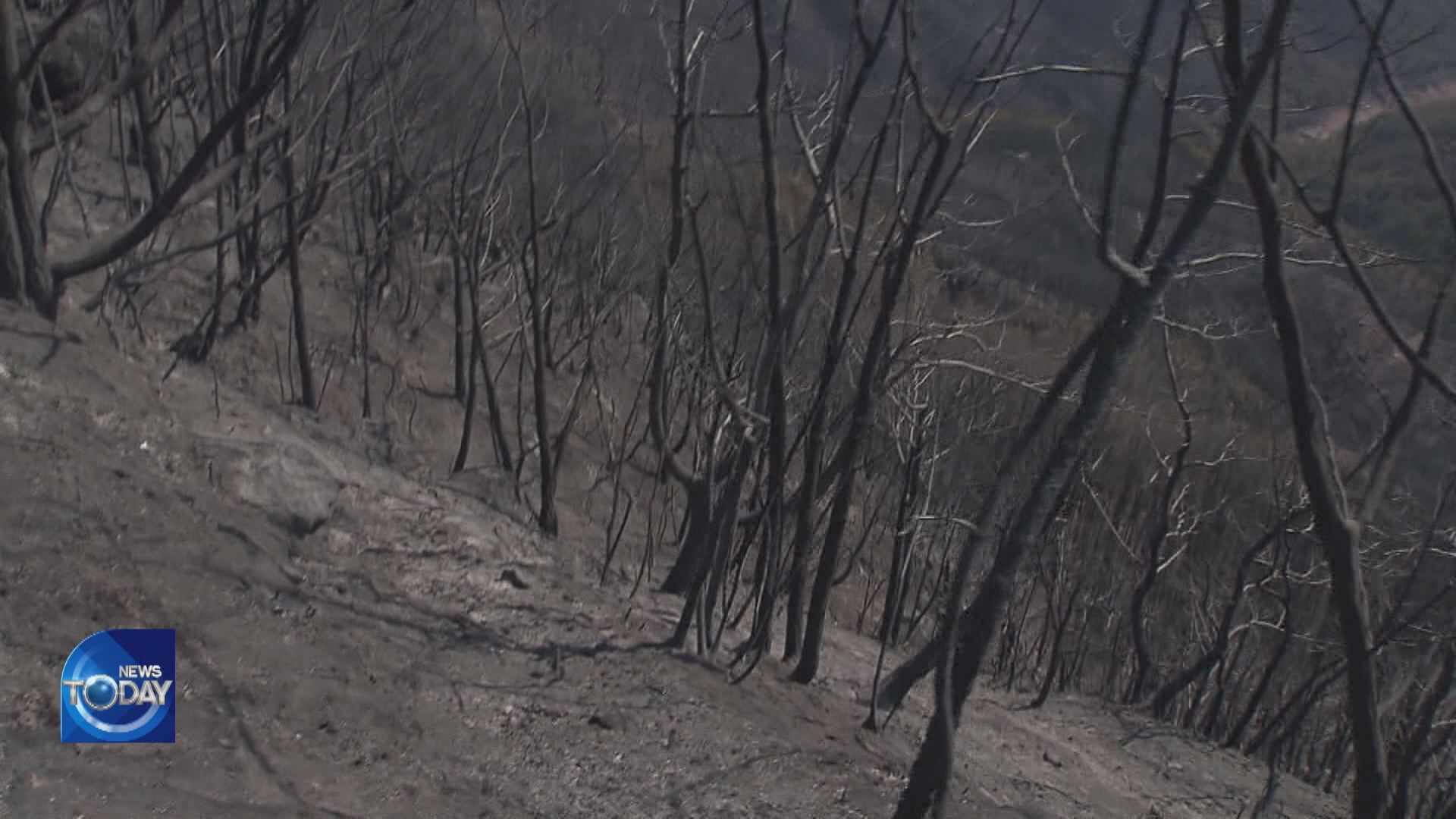DAMAGES FROM CONTINUING WILDFIRES
입력 2022.03.11 (15:01)
수정 2022.03.11 (16:46)
읽어주기 기능은 크롬기반의
브라우저에서만 사용하실 수 있습니다.
[Anchor Lead]
The wildfires raging in Uljin for the eighth straight day have destroyed around 20,000 ha of forestland. Scores of trees have been burned. Those that appear normal on the outside may have been damaged on the inside and could die soon.
[Pkg]
Acres and acres of forestland swept by wildfires... Pine trees are charred and their needles completely burnt. These 50-year-old Geumgang pines have also bore the brunt of the devastating wildfires. In just one week, these evergreen trees have turned brown. The quality of soil plays a decisive part in pine trees' growth, more so than other trees. When soil quality deteriorates, their growth becomes hampered down to their roots.
[Soundbite] Seo Jae-chul(Green Korea) : "When fires impact soil quality, some trees cannot survive even when their stems are not damaged seriously."
To restore burned down forests, badly damaged trees must be cut and new trees must be planted. But this is not an easy task in Uljin, which is home to steep mountains. It will take at least three decades to restore the area's ecosystem to its original state, including microorganisms in the soil as well as its local flora and fauna.
[Soundbite] Kim Pyeong-ki(Uljin National Forest Supervisor's Office) : "Various factors should be taken into consideration, such as topography, tree species that can live in local conditions and soil."
The area destroyed by wildfires in Uljin is similar in size to the city of Daegu. Measures are also needed to restore forest resources as local farmers make their living by cultivating pine mushrooms.
The wildfires raging in Uljin for the eighth straight day have destroyed around 20,000 ha of forestland. Scores of trees have been burned. Those that appear normal on the outside may have been damaged on the inside and could die soon.
[Pkg]
Acres and acres of forestland swept by wildfires... Pine trees are charred and their needles completely burnt. These 50-year-old Geumgang pines have also bore the brunt of the devastating wildfires. In just one week, these evergreen trees have turned brown. The quality of soil plays a decisive part in pine trees' growth, more so than other trees. When soil quality deteriorates, their growth becomes hampered down to their roots.
[Soundbite] Seo Jae-chul(Green Korea) : "When fires impact soil quality, some trees cannot survive even when their stems are not damaged seriously."
To restore burned down forests, badly damaged trees must be cut and new trees must be planted. But this is not an easy task in Uljin, which is home to steep mountains. It will take at least three decades to restore the area's ecosystem to its original state, including microorganisms in the soil as well as its local flora and fauna.
[Soundbite] Kim Pyeong-ki(Uljin National Forest Supervisor's Office) : "Various factors should be taken into consideration, such as topography, tree species that can live in local conditions and soil."
The area destroyed by wildfires in Uljin is similar in size to the city of Daegu. Measures are also needed to restore forest resources as local farmers make their living by cultivating pine mushrooms.
■ 제보하기
▷ 카카오톡 : 'KBS제보' 검색, 채널 추가
▷ 전화 : 02-781-1234, 4444
▷ 이메일 : kbs1234@kbs.co.kr
▷ 유튜브, 네이버, 카카오에서도 KBS뉴스를 구독해주세요!
- DAMAGES FROM CONTINUING WILDFIRES
-
- 입력 2022-03-11 15:01:52
- 수정2022-03-11 16:46:45

[Anchor Lead]
The wildfires raging in Uljin for the eighth straight day have destroyed around 20,000 ha of forestland. Scores of trees have been burned. Those that appear normal on the outside may have been damaged on the inside and could die soon.
[Pkg]
Acres and acres of forestland swept by wildfires... Pine trees are charred and their needles completely burnt. These 50-year-old Geumgang pines have also bore the brunt of the devastating wildfires. In just one week, these evergreen trees have turned brown. The quality of soil plays a decisive part in pine trees' growth, more so than other trees. When soil quality deteriorates, their growth becomes hampered down to their roots.
[Soundbite] Seo Jae-chul(Green Korea) : "When fires impact soil quality, some trees cannot survive even when their stems are not damaged seriously."
To restore burned down forests, badly damaged trees must be cut and new trees must be planted. But this is not an easy task in Uljin, which is home to steep mountains. It will take at least three decades to restore the area's ecosystem to its original state, including microorganisms in the soil as well as its local flora and fauna.
[Soundbite] Kim Pyeong-ki(Uljin National Forest Supervisor's Office) : "Various factors should be taken into consideration, such as topography, tree species that can live in local conditions and soil."
The area destroyed by wildfires in Uljin is similar in size to the city of Daegu. Measures are also needed to restore forest resources as local farmers make their living by cultivating pine mushrooms.
The wildfires raging in Uljin for the eighth straight day have destroyed around 20,000 ha of forestland. Scores of trees have been burned. Those that appear normal on the outside may have been damaged on the inside and could die soon.
[Pkg]
Acres and acres of forestland swept by wildfires... Pine trees are charred and their needles completely burnt. These 50-year-old Geumgang pines have also bore the brunt of the devastating wildfires. In just one week, these evergreen trees have turned brown. The quality of soil plays a decisive part in pine trees' growth, more so than other trees. When soil quality deteriorates, their growth becomes hampered down to their roots.
[Soundbite] Seo Jae-chul(Green Korea) : "When fires impact soil quality, some trees cannot survive even when their stems are not damaged seriously."
To restore burned down forests, badly damaged trees must be cut and new trees must be planted. But this is not an easy task in Uljin, which is home to steep mountains. It will take at least three decades to restore the area's ecosystem to its original state, including microorganisms in the soil as well as its local flora and fauna.
[Soundbite] Kim Pyeong-ki(Uljin National Forest Supervisor's Office) : "Various factors should be taken into consideration, such as topography, tree species that can live in local conditions and soil."
The area destroyed by wildfires in Uljin is similar in size to the city of Daegu. Measures are also needed to restore forest resources as local farmers make their living by cultivating pine mushrooms.
이 기사가 좋으셨다면
-
좋아요
0
-
응원해요
0
-
후속 원해요
0

















이 기사에 대한 의견을 남겨주세요.